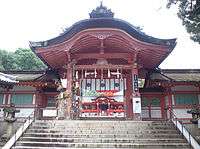Iwashimizu Hachimangū
| Iwashimizu Hachiman Shrine 石清水八幡宮 | |
|---|---|
|
The Iwashimizu Hachiman Shrine | |
| Information | |
| Type |
Hachiman Shrine Kokushigenzaisya Twenty-Two Shrines Chokusaisha Beppyo jinja Shikinaisya Former kanpeitaisha |
| Dedicated to | Hachiman |
| Founded | 859 |
| Reisai | iwashimizu-sai (石清水祭) (September 15th) |
| Honden style | Hachiman-zukuri |
| Address | Yawata, Kyoto |
| Website |
www |
|
| |

Iwashimizu Hachimangū (石清水八幡宮) is a Shinto shrine in the city of Yawata in Kyoto Prefecture, Japan.
History
The shrine's Heian period connections with the Kyoto and the Imperial family date from its founding in 859 (Jōgan 1)[1] when construction on its earliest structures commenced.[2] Shrine tradition explains that Emperor Seiwa ordered the shrine to be built in obeisance to an oracle in which the god Hachiman expressed the desire to be near to Kyoto to watch over the city and the Imperial House of Japan.[3] This vision was reported by a Buddhist monk, Gyōkyō, who had a second vision which led to selecting the Otokoyama location where the shrine now stands.[4] Like other Hachiman shrines, until 1868 Iwashimizu was actually a shrine-temple complex (jingū-ji) called Iwashimizu Hachimangū-ji (石清水八幡宮寺) dedicated to Buddhism as much as to kami worship.[5]
The shrine became the object of Imperial patronage during the early Heian period.[6] In 965, Emperor Murakami ordered that Imperial messengers were sent to report important events to the guardian kami of Japan. These heihaku were initially presented to 16 shrines including the Ōharano Shrine.[7]
The shrine's importance and influence grew in succeeding centuries; and its extensive landholdings led to modest conflicts with Minamoto no Yoritomo during the years in which the Kamakura shogunate was establishing itself. The shrine sought to maintain its traditional exemption from contributing to paying the costs of military forces.[8] In time, the bakufu faded away; and the shrine endured.
Iwashimizu Hachimangū and Ise Shrine were specified for "the two ancestral mausoleum" (二所宗廟) in the Middle Ages.
- 1456 (Kōshō 2, 3rd month): Ashikaga Yoshimasa visited Iwashimizu Shrine; and all the officials of the Daijō-kan joined him in going there.[9]
From 1871 through 1946, Iwashimizu Hachimangū was officially designated one of the Kanpei-taisha (官幣大社), meaning that it stood in the first rank of government supported shrines. Other similarly honored Hachiman shrines were Usa Shrine of Usa in Ōita Prefecture and Hakozaki-gū of Fukuoka in Fukuoka Prefecture.[10]
Imperial progresses to the shrine
In 979 (Tengen 2), Emperor Enyū visited the shrine; and the shrine continued to be visited by nearly all the emperors until the reign of Emperor Go-Daigo, when the sovereigns began to live more secluded lives.[11]
In the Shōhei era (1346–1370), Emperor Murakami visited Iwashimizu in person.[12]
After the Ōnin war (1467–1477), Imperial visits were held in abeyance for 200 years.[13]
Shinto belief
The shrine is dedicated to the veneration of Hachiman, the Shinto kami or spirit guardian of Imperial legitimacy.[1] Since the time of its founding in 859, Hachiman has been recognized as Emperor Ojin.[14]
Treasures
A 2005 survey of the treasures at Iwashimizu revealed, among other things, the existence of a kris, a jeweled Indonesian dagger, which was exhibited at Kyoto National Museum as part of an exhibit entitled "Famous Swords from Kyoto's Temples and Shrines."[15]
See also
- List of Shinto shrines
- Twenty-Two Shrines
- Modern system of ranked Shinto Shrines
- Minamoto no Yorinobu
- Minamoto no Yoriyoshi
Notes
- 1 2 Kanda, Christine Guth. (1985). Shinzō: Hachiman Imagery and Its Development, p. 41.
- ↑ Brown, Delmer et al. (1979). Gukanshō, p. 288.
- ↑ Ponsonby-Fane, Richard. (1962). Studies in Shinto and Shrines, p. 78.
- ↑ Kanda, p. 42.
- ↑ Satō, Makoto: "Shinto and Buddhism". Encyclopedia of Shinto, Kokugakuin University, retrieved on August 14, 2011
- ↑ Breen, John et al. (2000). Shinto in History: Ways of the Kami, pp. 74-75.
- ↑ Ponsonby-Fane, Studies, pp. 116-117.
- ↑ Maas, Jeffrey P. (1999). Yoritomo and the Founding of the First Bakufu: The Origins of Dual Government in Japan, p. 202.
- ↑ Titsingh, p. 348.
- ↑ Ponsonby-Fane, Richard Arthur Brabazon. (1959). The Imperial House of Japan, pp. 124-126.
- ↑ Ponsonby-Fane, Studies, p. 116.
- ↑ Ponsonby-Fane, Studies, p. 218.
- ↑ Ponsonby-Fane, Studies,, p. 244.
- ↑ Ponsbonby-Fane, Studies, pp. 78, 196.
- ↑ Kyoto National Museum: 2006 exhibition, treasures
References
- Breen, John and Mark Teeuwen. (2000). Shinto in History: Ways of the Kami. Honolulu: University of Hawaii Press. ISBN 978-0-8248-2362-7; ISBN 9780824823634; OCLC 43487317
- Brown, Delmer M. and Ichirō Ishida, eds. (1979). Gukanshō: The Future and the Past. Berkeley: University of California Press. ISBN 978-0-520-03460-0; OCLC 251325323
- Kanda, Christine Guth. (1985). Shinzō: Hachiman Imagery and Its Development. Cambridge: Harvard University Press. ISBN 978-0-674-80650-4
- Ponsonby-Fane, Richard. (1959). The Imperial House of Japan. Kyoto: Ponsonby Memorial Society. OCLC 194887
- ____________. (1962). Studies in Shinto and Shrines. Kyoto: Ponsonby Memorial Society. OCLC 399449
- ____________. (1963). Vicissitudes of Shinto. Kyoto: Ponsonby Memorial Society. OCLC 36655
- Maas, Jeffrey P. (1999). Yoritomo and the Founding of the First Bakufu: The Origins of Dual Government in Japan. Stanford: Stanford University Press. ISBN 978-0-8047-3591-9
- Titsingh, Isaac. (1834). Nihon Odai Ichiran; ou, Annales des empereurs du Japon. Paris: Royal Asiatic Society, Oriental Translation Fund of Great Britain and Ireland. OCLC 5850691
External links
| Wikimedia Commons has media related to Iwashimizu Hachimangū. |
- (Japanese) Iwashimizu Hachimangū web site (in Japanese)
- Photos of Iwashimizu Hachimangū and references in ancient Japanese literature
Coordinates: 34°52′47″N 135°42′00″E / 34.87972°N 135.70000°E
